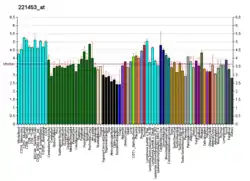G6PC2
Glucose-6-phosphatase 2 is an enzyme that in humans is encoded by the G6PC2 gene.[5][6][7]
Function
This gene encodes an enzyme belonging to the glucose-6-phosphatase catalytic subunit family. These enzymes are part of a multicomponent integral membrane system that catalyzes the hydrolysis of glucose-6-phosphate, the terminal step in gluconeogenic and glycogenolytic pathways, allowing the release of glucose into the bloodstream. The family member encoded by this gene is found in pancreatic islets and does not exhibit phosphohydrolase activity, but it is a major target of cell-mediated autoimmunity in diabetes. Several alternatively spliced transcript variants of this gene have been described, but their biological validity has not been determined.[7]
References
- ENSG00000152254 GRCh38: Ensembl release 89: ENSG00000278373, ENSG00000152254 - Ensembl, May 2017
- GRCm38: Ensembl release 89: ENSMUSG00000005232 - Ensembl, May 2017
- "Human PubMed Reference:". National Center for Biotechnology Information, U.S. National Library of Medicine.
- "Mouse PubMed Reference:". National Center for Biotechnology Information, U.S. National Library of Medicine.
- Arden SD, Zahn T, Steegers S, Webb S, Bergman B, O'Brien RM, Hutton JC (Mar 1999). "Molecular cloning of a pancreatic islet-specific glucose-6-phosphatase catalytic subunit-related protein". Diabetes. 48 (3): 531–42. doi:10.2337/diabetes.48.3.531. PMID 10078553.
- Ebert DH, Bischof LJ, Streeper RS, Chapman SC, Svitek CA, Goldman JK, Mathews CE, Leiter EH, Hutton JC, O'Brien RM (Mar 1999). "Structure and promoter activity of an islet-specific glucose-6-phosphatase catalytic subunit-related gene". Diabetes. 48 (3): 543–51. doi:10.2337/diabetes.48.3.543. PMID 10078554.
- "Entrez Gene: G6PC2 glucose-6-phosphatase, catalytic, 2".
Further reading
- Martin CC, Bischof LJ, Bergman B, Hornbuckle LA, Hilliker C, Frigeri C, Wahl D, Svitek CA, Wong R, Goldman JK, Oeser JK, Leprêtre F, Froguel P, O'Brien RM, Hutton JC (2001). "Cloning and characterization of the human and rat islet-specific glucose-6-phosphatase catalytic subunit-related protein (IGRP) genes". J. Biol. Chem. 276 (27): 25197–207. doi:10.1074/jbc.M101549200. PMID 11297555.
- Lieberman SM, Evans AM, Han B, Takaki T, Vinnitskaya Y, Caldwell JA, Serreze DV, Shabanowitz J, Hunt DF, Nathenson SG, Santamaria P, DiLorenzo TP (2003). "Identification of the beta cell antigen targeted by a prevalent population of pathogenic CD8+ T cells in autoimmune diabetes". Proc. Natl. Acad. Sci. U.S.A. 100 (14): 8384–8. doi:10.1073/pnas.0932778100. PMC 166238. PMID 12815107.
- Petrolonis AJ, Yang Q, Tummino PJ, Fish SM, Prack AE, Jain S, Parsons TF, Li P, Dales NA, Ge L, Langston SP, Schuller AG, An WF, Tartaglia LA, Chen H, Hong SB (2004). "Enzymatic characterization of the pancreatic islet-specific glucose-6-phosphatase-related protein (IGRP)". J. Biol. Chem. 279 (14): 13976–83. doi:10.1074/jbc.M307756200. PMID 14722102.
- Shieh JJ, Pan CJ, Mansfield BC, Chou JY (2004). "The islet-specific glucose-6-phosphatase-related protein, implicated in diabetes, is a glycoprotein embedded in the endoplasmic reticulum membrane". FEBS Lett. 562 (1–3): 160–4. doi:10.1016/S0014-5793(04)00223-6. PMID 15044018. S2CID 7523290.
- Shieh JJ, Pan CJ, Mansfield BC, Chou JY (2006). "In islet-specific glucose-6-phosphatase-related protein, the beta cell antigenic sequence that is targeted in diabetes is not responsible for the loss of phosphohydrolase activity". Diabetologia. 48 (9): 1851–9. doi:10.1007/s00125-005-1848-6. PMID 16012821.
- Yang J, Danke NA, Berger D, Reichstetter S, Reijonen H, Greenbaum C, Pihoker C, James EA, Kwok WW (2006). "Islet-specific glucose-6-phosphatase catalytic subunit-related protein-reactive CD4+ T cells in human subjects". J. Immunol. 176 (5): 2781–9. doi:10.4049/jimmunol.176.5.2781. PMID 16493034.
- Dogra RS, Vaidyanathan P, Prabakar KR, Marshall KE, Hutton JC, Pugliese A (2006). "Alternative splicing of G6PC2, the gene coding for the islet-specific glucose-6-phosphatase catalytic subunit-related protein (IGRP), results in differential expression in human thymus and spleen compared with pancreas". Diabetologia. 49 (5): 953–7. doi:10.1007/s00125-006-0185-8. PMID 16520917.
- Unger WW, Pinkse GG, Mulder-van der Kracht S, van der Slik AR, Kester MG, Ossendorp F, Drijfhout JW, Serreze DV, Roep BO (2007). "Human clonal CD8 autoreactivity to an IGRP islet epitope shared between mice and men". Ann. N. Y. Acad. Sci. 1103: 192–5. doi:10.1196/annals.1394.024. PMID 17376840. S2CID 38880605.
- Li DZ, Liao C, Tang XW (2007). "Prenatal diagnosis of glycogen storage disease type Ia, presenting a new mutation in the glucose-6-phosphatase gene". Prenat. Diagn. 27 (7): 685–6. doi:10.1002/pd.1764. PMID 17607665. S2CID 9052649.





